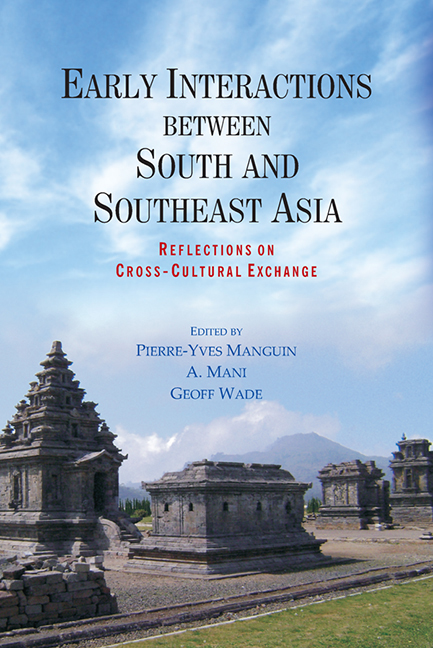Book contents
- Frontmatter
- Contents
- FOREWORD
- Preface
- Introduction
- PART I New Archaeological Evidence from South Asia and Southeast Asia
- PART II Localisation in Southeast Asia
- 11 Tamil Merchants and the Hindu-Buddhist Diaspora in Early Southeast Asia
- 12 The Spread of Sanskrit in Southeast Asia
- 13 The Early Inscriptions of Indonesia and the Problem of the Sanskrit Cosmopolis
- 14 Indian Architecture in the ‘Sanskrit Cosmopolis’: The Temples of the Dieng Plateau
- 15 The Importance of Gupta-period Sculpture in Southeast Asian Art History
- 16 Individuals under the Glaze: Local Transformations of Indianisation in the Decorative Lintels of Angkor
- 17 Early Musical Exchange between India and Southeast Asia
- 18 Buddhism and the Circulation of Ritual in Early Peninsular Southeast Asia
- 19 Early Buddhism in Myanmar: Ye Dhammā Inscriptions from Arakan
- 20 Hindu Deities in Southern Vietnam: Images on Small Archaeological Artefacts
- 21 ‘The Depositing of the Embryo’ – Temple Consecration Rituals in the Hindu Tradition of South and Southeast Asia: A Study of the Textual and Archaeological Evidence
- 22 Localisation of Indian Infl uences as Refl ected in the Laotian Versions of the Ramayana
- 23 Broken Threads: Contested Histories of Brahminism in Cambodia and Thailand and the Construction of Ritual Authority
- LIST OF CONTRIBUTORS
- INDEX
19 - Early Buddhism in Myanmar: Ye Dhammā Inscriptions from Arakan
from PART II - Localisation in Southeast Asia
Published online by Cambridge University Press: 21 October 2015
- Frontmatter
- Contents
- FOREWORD
- Preface
- Introduction
- PART I New Archaeological Evidence from South Asia and Southeast Asia
- PART II Localisation in Southeast Asia
- 11 Tamil Merchants and the Hindu-Buddhist Diaspora in Early Southeast Asia
- 12 The Spread of Sanskrit in Southeast Asia
- 13 The Early Inscriptions of Indonesia and the Problem of the Sanskrit Cosmopolis
- 14 Indian Architecture in the ‘Sanskrit Cosmopolis’: The Temples of the Dieng Plateau
- 15 The Importance of Gupta-period Sculpture in Southeast Asian Art History
- 16 Individuals under the Glaze: Local Transformations of Indianisation in the Decorative Lintels of Angkor
- 17 Early Musical Exchange between India and Southeast Asia
- 18 Buddhism and the Circulation of Ritual in Early Peninsular Southeast Asia
- 19 Early Buddhism in Myanmar: Ye Dhammā Inscriptions from Arakan
- 20 Hindu Deities in Southern Vietnam: Images on Small Archaeological Artefacts
- 21 ‘The Depositing of the Embryo’ – Temple Consecration Rituals in the Hindu Tradition of South and Southeast Asia: A Study of the Textual and Archaeological Evidence
- 22 Localisation of Indian Infl uences as Refl ected in the Laotian Versions of the Ramayana
- 23 Broken Threads: Contested Histories of Brahminism in Cambodia and Thailand and the Construction of Ritual Authority
- LIST OF CONTRIBUTORS
- INDEX
Summary
Arakan is one of the fourteen states and divisions that composed together in the Union of Myanmar (formerly Burma). It is located on the boundary of present-day Myanmar and Bangladesh. Situated east of Vanga and Samatata of ancient India, Arakan was in olden days a thriving, independent border state beyond the Indian subcontinent. Indologists who write about the history and culture of ancient India have never mentioned this area where high standards of life, culture and art flourished. Under the cultural influence of India, city-states flourished in the first millennium of the Christian Era (CE). They are Dhaññavatī and Vesālī. The Gupta-period sculptures point the city of Dhaññavatī to the fifth century CE (Gutman 2001: 19) and art and numismatic studies place Vesālī between about sixth and tenth centuries CE (Gutman 1976; 2001: 41), although a fourteenth-century radiocarbon date from a city gatepost suggests intermittent reoccupation (Hudson 2005).
About fifty Sanskrit and Pāli inscriptions written in Gupta, Devanāgarī and proto-Bengali scripts between the period of fifth and tenth centuries CE were found in Arakan. Most of the inscriptions can be assigned to the Vesālī period. Interestingly, none of the inscriptions found in Arakan during the first millennium CE were inscribed in vernacular languages; all were written in the classical languages of Sanskrit or Pāli using Indian scripts. This is due to the cultural impact, especially the Buddhicisation, of ancient India on this region which is situated very close to the subcontinent.
Most of the inscriptions from the Vesālī period bear the gāthā (verse) of ye dhammā. According to archaeological data, the ye dhammā verses were first inscribed around the fifth-sixth centuries (Mya 1961b: 17). We do not know whether the custom of inscribing the ye dhammā gāthā appeared first among the Mahāyāna or Theravāda schools. However, most of the ye dhammā inscription of the fifth century CE were written in Pāli. Between sixth and seventh centuries, the ye dhammā gāthā were commonly in usage both in Pāli and Sanskrit languages.
- Type
- Chapter
- Information
- Early Interactions between South and Southeast AsiaReflections on Cross-Cultural Exchange, pp. 385 - 406Publisher: ISEAS–Yusof Ishak InstitutePrint publication year: 2011



